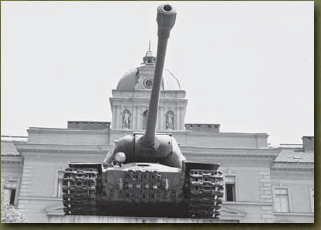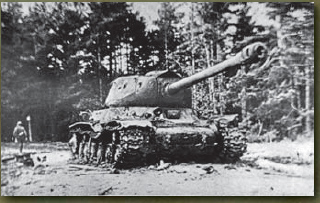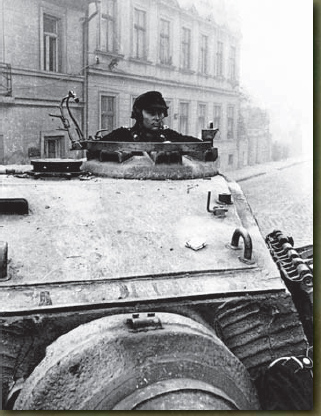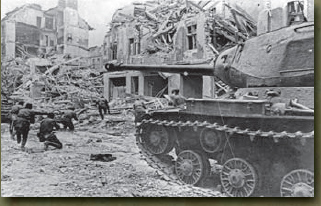CHRONOLOGY
| 1937 | |
| January | Henschel is contracted to develop a heavy breakthrough tank that eventually becomes the Tiger I. |
| 1941 | |
| June 22 | Operation Barbarossa begins; German forces first encounter the Soviet T-34. |
| 1942 | |
| September 16 | The Tiger I is first used in combat with 502nd Heavy Panzer Battalion just south of Lake Ladoga, in the Leningrad sector. |
| 1943 | |
| February 2 | Krupp’s prototype (later “series production”) turret is delivered for testing at the Kummersdorf research facility. |
| July 4–17 | Operation Zitadelle takes place in the Kursk area. |
| July–August | Development of the Tiger II and IS-2 begins. |

An IS-2 with a hard-edged welded nose, mistakenly promoted as the first Soviet tank to enter Prague, sits atop a monument in that city’s Štefánik Square. Attachments between the towing shackles hold spare track links. Following the “Velvet Revolution” in 1989 the vehicle was painted pink to protest against the former Soviet/Warsaw Pact occupation. (DML)
| 1944 | |
| March 14 | The first Tiger IIs are issued to Panzer Lehr Division’s Panzer Company (FKL) 316 as radio-control vehicles for the tracked BIV Sprengstoffträger explosive carrier. |
| April | IS-2s are first deployed to combat during the Proskurov–Chernovtsy and Uman–Botoshany offensives with 11th and 72nd Guards Heavy Tank Regiments. |
| July 18 | Operation Atlantic in Normandy sees Tiger IIs first used in combat, with 1st Company, 503rd Heavy Panzer Battalion. |
| August 13 | Tiger IIs are first used on the Eastern Front, at the Sandomierz bridgehead with 501st Heavy Panzer Battalion against IS-2s of 71st Guards Heavy Tank Regiment. |
| December | The Soviets create Guards heavy tank brigades to organize existing IS-2 regiments. |

An early-model “broken-nose” IS-2 that appears to be disabled, judging by its missing return roller and disheveled appearance. Its horn and headlight have remained intact. (DML)
| 1945 | |
| January 12 | Tiger IIs from 524th Heavy Panzer Battalion confront IS-2s of 13th Guards Heavy Tank Regiment near Lisów, Poland. |
| Operation Konrad sees IS-2s and Tiger IIs of Heavy Panzer Battalion Feldherrnhalle clash during the siege of Budapest. | |
| February 15 | 11th SS Volunteer Panzergrenadier Division Nordland precedes the main Sonnenwende operation in an effort to relieve the Arnswalde garrison. |
| February 16 | Operation Sonnenwende begins and a corridor to Arnswalde is opened. |
| February 17 | Second Guards Tank Army arrives in the Arnswalde area. |
| February 21 | German forces participating in Sonnenwende go over to the defensive as the Arnswalde garrison begins to evacuate. |
| February 23 | With the Germans back to their initial positions along the Ihna River the Soviets renew their general offensive to clear Pomerania. |
| March 29 | The final Tiger II is picked up from the factory. |
| April–May | IS-2s and Tiger IIs (502nd and 503rd Heavy SS Panzer Battalions) fight against each other for the final time during the Battle of Berlin. |

A close-up of a Tiger II of 503rd Heavy Panzer Battalion in Budapest in October 1944, showing the commander’s aiming rod, one of the vehicle’s three “Pilz” mounts, and the cupola-mounted antiaircraft support, minus its machine gun. Because of the Tiger II’s impressive size it was frequently photographed; here it is part of a series of propaganda shots. (DML)

Two IS-2s provide infantry support in Berlin on April 27, 1945. The rough external appearance is apparent on the rear vehicle, which (strangely, considering the location and time) lacks friend-or-foe identification stripes along the turret sides. (DML)

Rear turret view of a Tiger II that is covered in anti-magnetic mine Zimmerit paste and lacks its cupola hatch cover. Because of its weight the rear turret door had a spring hinge to facilitate movement. (DML)